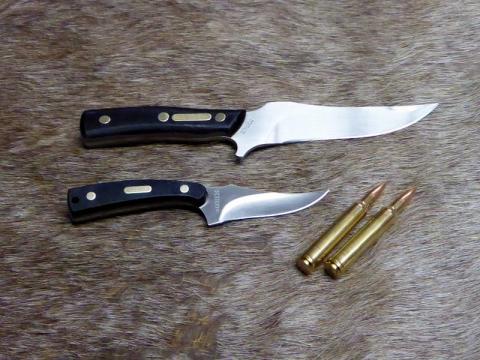
There are some things that by design are functionally efficient without embellishment or constant change. This is most certainly true with the Sharpfinger knife concept by Schrade (Taylor Brands). Simple, straightforward and without any need for change over time, this particular knife concept has proven itself for many decades. The simplicity of this knife design is not only enriched by the upswept clip-point blade pattern that functions as a superb hide removal tool, at the same time the knife also works exceedingly well as a total edged game care field tool.
In its current incarnation, there are two different size Sharpfinger fixed-blade knives. The most commonly encountered Sharpfinger model is the 152OT that features a 3 1/2” hollow ground blade with a pair of saw cut Delrin handle scales attached with a pair of brass rivets and paired with a brown leather sheath. The second model is the 150T that differs primarily from the former model only in overall size. Featuring a similar blade pattern, the blade on this model measures 6” in length and Delrin handle scales are somewhat longer, thicker and triple riveted. Furthermore, while this model also comes with a brown leather sheath, it features the addition of five rivets to secure the construction.
While both knives carry the “Old Timer” and “Sharpfinger” nomenclature, the original Schrade cutlery firm, formally headquartered in Ellenville, New York, no longer produces them. Schrade went out of business in 1974 and Taylor Brands purchased all of the properties of the firms including its trademarks. Current cutlery production, including that of both Sharpfinger models, is now performed offshore, primarily in Asia. While that fact may cause some concern among purchasers, the current global nature of manufacturing has made the shifting of domestic production to offshore producers a reality. While there may be some who believe because product quality has been diminished because of that, in this writer’s opinion neither the materials nor the craftsmanship have been negatively affected.
The stainless steel used in both Sharpfinger models is 7Cr17Mov, which is the Chinese equivalent of domestically produced 440A stainless. Heat-treated to Rc 55-57, this particular steel offers solid strength, good wear resistance and more than adequate toughness. When it comes to value, 7Cr17Mov is an unparalleled selection as it is not only imminently affordable, but also provides performance far beyond normal expectations. Combined with the fact that both knife models have few components (full tang blade, two handle scales and a couple of rivets), this use of this stainless alloy means that future service problems are virtually non-existent.
Delrin is a thermoplastic that bridges the gap between metal and plastic. This material offers high tensile strength, hardness and rigidity when used for knife handle scales. It’s not prone to chip, scratch or fracture easily like many other materials. Furthermore, when in contact with moisture, such as body fluids encountered when field dressing an animal, the external saw cut texture, rectangular shape and rounded edges offer a positive hand-to-knife-handle grip surface.
The Sharpfinger knife concept has been continually produced since the early 1970s by several different manufacturers, including Schrade, Bear and Sons and Camillus to name a few. Its continued popularity could be attributed to the functionality of the rather unusual blade shape. Not only does the design provide a pronounced blade belly to facilitate hide removal activities, the upswept tip works well in more detailed field dressing tasks such as coring-out the terminal end of the digestive system and head cape removal. Moreover, the integral raised thumb rest on the top of the blade spine, as well as the recessed choil on the ricasso in front of the handle, work together to provide enhanced protection from the blade edge and offer greater cutting control.
Lastly, both knife models come with formed, brown leather carrying sheaths. The smaller model 152OT sheath is stitched, while the larger model 152T is both stitched and riveted. The leather used in both sheaths has a smooth finish and appears to be an adequate weight to provide years of service. For those who would like something a little different, aftermarket custom Kydex and leather sheaths for either knife models are easily found.
I’ve used a Sharpfinger fixed-blade for many years on a wide variety of North American, European and African game. The performance of this knife design was exceptional in every instance. When you consider the initial cost and combine that with outstanding functional performance, Sharpfinger knives are in a class all by themselves.–Durwood Hollis
